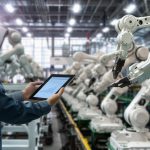Being smart at the Intelligent Edge
The Internet of Things (IoT) offers new ways to drive efficiencies, engage customers, and develop new business with greater insights at the Intelligent Edge. This requires more and more computing power at the edge to capture and analyze data right where it is generated. This can be in a car, in a factory, on a farm, or on an oil rig in the middle of the ocean.
In the past your datacenter estate was owned and operated by your IT department, protected by a strong firewall. Today a lot of your computational requirements are driven by operational or workplace needs and can no longer be managed by the central data center alone, but require fast and flexible solutions that connect the core with the edge.
This changes the role of IT as it is no longer only about technology. IT decisions become business decisions that need to address the customers’ challenges and how companies can use IT to improve their outcomes to add value to their business and their customers.
Our customers clearly see the advantage of edge computing and want to know what it takes to move to the edge, operate from there, and send data to the cloud and the core.
Ready to move to the edge? Here are four points you should consider:
1. Information Technology (IT) and Operational Technology (OT) need to work better together
It’s time. In the past the IT department and the operational team may not have had much interaction and were working independent of each other with different goals. Now, there needs to be an understanding of the needs, roles, and responsibilities as their cross-functional alliance will help them achieve new innovations, cost efficiencies, and more.
2. Put special focus on risk management and security
With some of the most sensitive data being collected at the edge, traditional security measures cannot always protect this data. Your security needs to prevent physical access to the network through IoT devices and safeguard the data collected and processed at the edge.
With more compute at the edge, boundaries are becoming more diffused and are subject to attacks. The IoT confronts us with unique security challenges because it puts data, computing power, communications, and potentially insecure sensors and other devices in complex environments like manufacturing plants, smart cities, and enterprises where traditional IT security measures don’t always apply.
3. Consider the impact on the end user
Today operational technology such as control systems, industrial networks, data acquisition systems and sensors can all be integrated at the edge. This enables immediate action right where the data is generated.
Companies are looking for new ways to minimize costly interruptions and process breakdowns caused by equipment failures and maintenance activities by harnessing the real-time data from IoT devices and operational data at the data centers. Organizations in all sectors and industries want to move from disruptive, reactive maintenance to a more proactive, future-ready approach such as digital predictive maintenance. Asset maintenance can be optimized through machine learning and AI-enabled services that proactively prevent downtimes by monitoring data across multiple machines, detect irregularities and predict failures to prevent human errors.
Take, for example, Texmark Chemicals of Texas, a leading producer of DCPD (dicyclopentadiene), a polymer precursor for everything from ink to boats. Their first business priority is safety. Many of the materials the company works with are hazardous, flammable, or both, and are heavily regulated. Texmark must ensure its workers adhere to Process Safety Management (PSM) procedures at all times, and that its facility is managed in ways that put worker and community safety first.
In addition, Texmark must continually drive plant efficiency and productivity. Depending solely on physical inspections carries risk because it relies on highly-skilled employees who—based on years of experience—can tell if a pump is starting to malfunction by recognizing slight variations in its noise and vibrations. But what happens if an employee with that skill is out sick, or reaches retirement age? Texmark needs ways to institutionalize that type of intelligence and insight.
Preventive analytics and digital predictive maintenance are invaluable for Texmark to generate insights, automate its environment, and reduce the risk of human error. Take a look at the entire case study learn more about Texmark’s refinery of the future.
People are key in the transition to this new way of working and employees need to know how to use the new capabilities. They need to know how to integrate, configure and maintain the new equipment, and they need to collaborate to make it all work.
Management of Change helps enable a smooth transition to a new IoT environment by minimizing resistance, increasing productivity and effective use of new IoT application, raising awareness for security and compliance, reducing the risk of delay or failure of the transformation and ensuring that all impacted functions and individuals are ready to adopt the changes.
4. What will happen with all the data?
To make the edge smarter, we need to shift more computing power there. But then what happens to the mountains of data that are being captured at the edge? To unlock the insights and intelligence that live within our ever-growing volumes of data, we have developed expertise, services and an entirely new computing architecture: memory-driven computing, built around memory rather than processors, where memory is central to the system, not just something connected to a processor. Such a system could hold hundreds of terabytes or even petabytes in memory at one time and could solve problems thousands of times faster than a conventional computer.
Memory-driven computing is our largest and most complex research project designed to deliver a new computer that will enable critical leaps in performance, allowing us to extract insights from data like never before.
Find out more about our latest memory-driven announcements and learn what memory-driven computing means for your industry.
How you can leverage the Intelligent Edge for your business
The Intelligent Edge is an exciting place that offers great business opportunities. No matter if you are just getting started or if you are already in the middle of your digital transformation, contact us to learn how we can help you harness the edge for your business and accelerate your business outcomes.
Originally this article was published here.
![]() This article was written by Parvesh Sethi. He is a Senior Global Executive at HPE, who brings the strong combination of transformation experience, technology expertise and business acumen. Visionary leader with a track record in leading complex, international organizations to achieve extraordinary results. HPE Edgeline Converged Edge Systems is powered by Intel® Xeon®
This article was written by Parvesh Sethi. He is a Senior Global Executive at HPE, who brings the strong combination of transformation experience, technology expertise and business acumen. Visionary leader with a track record in leading complex, international organizations to achieve extraordinary results. HPE Edgeline Converged Edge Systems is powered by Intel® Xeon®



